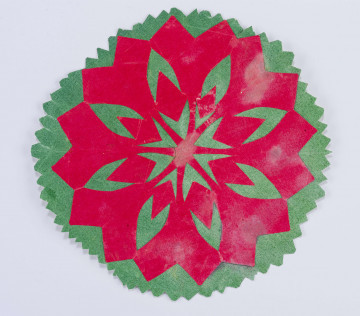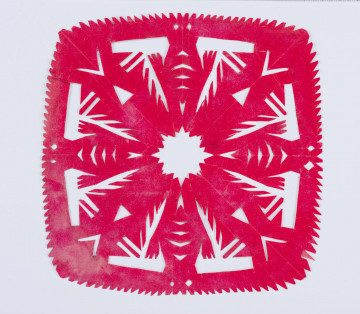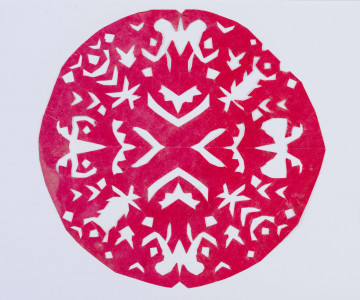
Cutout
1900 — 1920
National Museum in Lublin
Part of the collection: Folk Art of the Lublin Region (17th–1st half of the 20th c.)
One of the most favourite and most frequently cut out of coloured paper representations were flower trees, in which we can find the symbol of the tree of life, the axis connecting earth and heaven. They were also often accompanied by female figures symbolising the earth, the so-called dolls, and the motif of a rooster - believed to have the power of fertility. Abstract forms cut in the form of rosettes or squares were also popular. The variety of forms and patterns was determined by the skills of the cutters and the space of the country house which was to be decorated with them. Inspiration was sought in the art of the area, in the motifs and colours used in the painting of dowry chests or Easter eggs, and in the decoration of clothes - weaving or embroidery.
Rooster and other birds with decoratively extended tails - chickens, goose, quails, pigeons, storks, swans - were among the favourite patterns used by Ignacy Dobrzyński (1882-1960), a paper-cut artist from the area of Garbowo near Puławy. Initially, he made traditional geometric strip cut-outs with elements of peacock eyes, fish scales, trees and hearts, but with time he began to draw inspiration from nature. He transferred onto paper plants in fabulous shapes, including: stylised leaves of oak, parsley, clover, chestnut, twigs of leaves or conifers, various flowers and fruits, ears of grain or a variety of insects and animals: horses, deer, dogs, hares, butterflies, dragonflies, squirrels, goats. Human figures also appeared. The whole of this fine paper lace was closed in the shape of a circle, rosette, star or square, with the diameter not exceeding 35 cm. The artist also left behind several larger cut-outs, measuring up to 70 cm.
Based on simple cut-outs from Lublin, Dobrzyński created his own original style, which became a model for other artists: Lilia Soli from Puławy, Maria Gleń from Krasnystaw, Anna Słabczyńska from Lublin. For fifty years he has created hundreds of unique works of exquisite design and composition. They were shown at many exhibitions in Poland and abroad. They found their way into museum collections. The National Museum in Lublin owns the largest collection of about 700 works created by him and his children: son Jan and daughter Zofia, as well as granddaughter Bogumiła.
Author / creator
Dimensions
cały obiekt:
Object type
cutout
Technique
cutting
Material
Chalk paper
Creation time / dating
Creation / finding place
Owner
The National Museum in Lublin
Identification number
Location / status

1900 — 1920
National Museum in Lublin

1900 — 1920
National Museum in Lublin

1900 — 1920
National Museum in Lublin
DISCOVER this TOPIC
National Museum in Szczecin
DISCOVER this PATH
Educational path